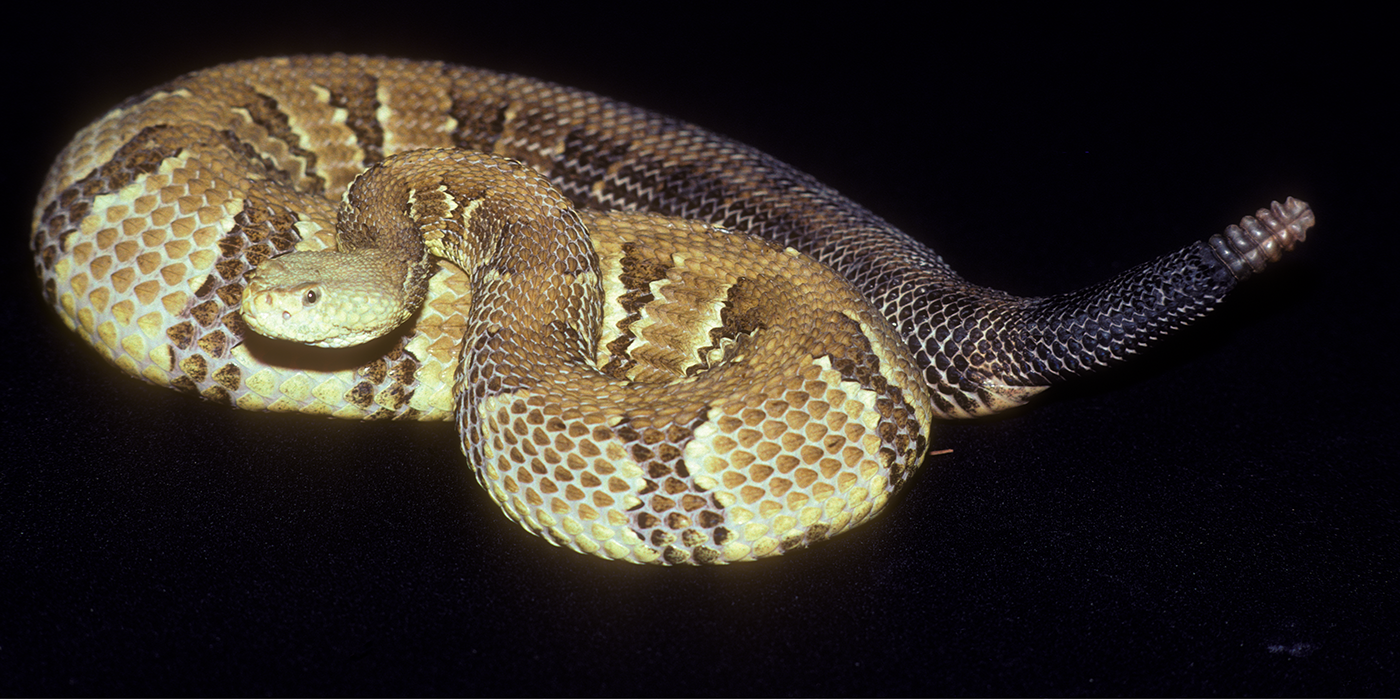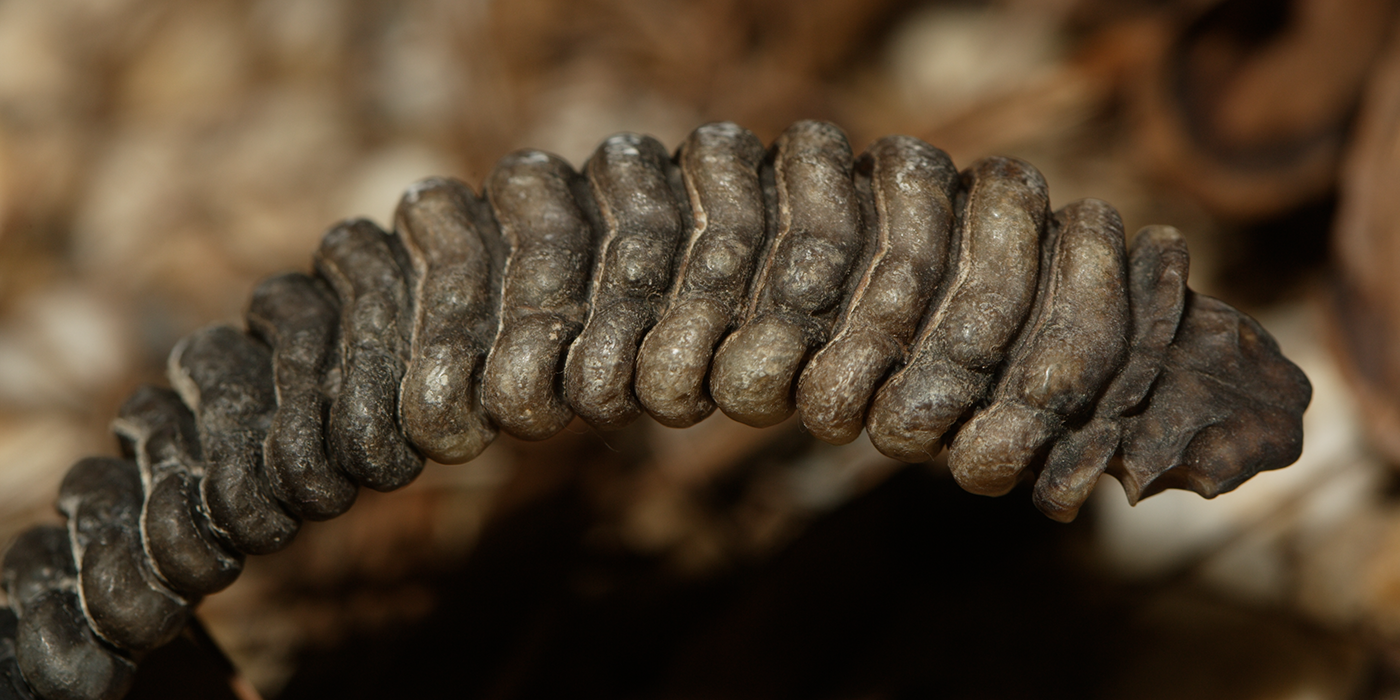Physical Description
These large, heavy pit vipers vary in coloration. They are gray, sometimes with a pinkish hue and have a stripe down their back. This stripe is orange, yellow or pinkish in some timber rattlesnakes, while others have a brown or black stripe.
Both morphs, or variations in color, have darker or black coloration at the tip of their tail and dark stripes that form a chevron pattern along the back and sides of the snake. This distinct pattern and coloration helps the timber rattlesnake camouflage among the vegetation on the ground.
Loose sections of the tail made of keratin (the same substance as human hair and fingernails) form the characteristic rattles or "buttons" at the tip of the timber rattlesnake's tail. When threatened, it props itself up and shakes its rattle, which presses the buttons together producing a rapid, crisp rattling sound.
The sound serves as a warning before the snake strikes. Though it may strike if necessary, the timber rattlesnake is more docile than other members of its family and is more likely to stay coiled or stretched out, motionless when encountered in the wild. Like other vipers, the timber rattlesnake is venomous with venom potent enough to kill a human. A timber rattlesnake bite is a medical emergency. However, timber rattlesnake bites are rare.
Size
Like other members of the pit viper family, the timber rattlesnake has a large, heavy-bodied appearance. Adults typically reach lengths of 2.5-5 feet (.76-1.5 meters), but there are reports of timber rattlesnakes growing up to 7 feet (2 meters) long.
Native Habitat
Timber rattlesnakes have a wide distribution across the eastern half of the United States. Their range extends from eastern Kansas, Texas, Iowa and central Wisconsin to Georgia, the Carolinas, West Virginia, western Virginia, Pennsylvania and New England. Timber rattlesnakes can be found as far north as New York and as far south as northern Florida. Historically, they were also found in southern Canada and Maine. This species is regionally extinct in Canada and threatened in several other parts of its range.
Timber rattlesnakes live in a variety of habitats, including mountainous or hilly forests, hardwood or pine forests, swamps and river floodplains, lowland cane thickets, and agricultural fields. Generally, those found in the western and higher altitude parts of its range are called timber rattlers. Those found in lower elevation areas, such as the Piedmont (a geographic region extending from New Jersey to Alabama) and the Atlantic Coastal Plain are called canebrakes. Canebrakes are found in swamps, the higher lands of river floodplains, and farmlands. Throughout their range, timber rattlesnakes seem to be less common in cities and suburbs.
These snakes are largely terrestrial but are amazing climbers and have been found in trees at heights of more than 80 feet. In the winter, they hibernate in crevices found on the ground or slightly underneath.
Food/Eating Habits
In the wild, timber rattlesnakes primarily eat small- to medium-sized rodents, such as mice, shrews, chipmunks and squirrels. They also eat birds, lizards and amphibians. They are ambush predators and capture prey by waiting patiently in the brush, and then quickly striking, biting and injecting venom into passing prey.
At the Zoo, timber rattlesnakes primarily eat mice and rats.
Sleep Habits
Social Structure
Reproduction and Development
Females mature at about 5 years old and reproduce every two to three years. Mating season takes place from spring to late summer. Males compete for females and display a courtship "dance." The dance has three steps; the male first slides next to the female, then rubs his head and body against her, and finally curls his tail under her tail to mate. Pregnant, or gravid, females move into more open habitat while males stay in habitats with more tree cover.
Timber rattlesnakes are viviparous, meaning they give birth to live young. A single litter can have three to 13 snakes. Young rattlesnakes resemble adults, except that they have only one button on their tail and may have a stripe from their eyes to their jaws. As they grow, the young snakes molt their skin creating room to grow additional rattles. Larger timber rattlesnakes may have up to five or six rattles and may shed a button as new buttons grow.
Conservation Efforts
As of a 2007 analysis, timber rattlesnakes are listed as a species of least concern on the International Union for Conservation of Nature's Red List. A current, long-term monitoring study may change their status. A closer look at its status in parts of its range reveals a more nuanced situation for this species.
In the northern part of their range, their regional classification varies from threatened to endangered. For example, in New Jersey the timber rattlesnake experienced a 50-66% population decline and is considered an endangered species. Likewise, timber rattlesnakes are endangered in Ohio, Connecticut, New Hampshire, Massachusetts and Vermont. They have been extirpated, or eradicated, in Maine.
Urban development is the greatest concern for timber rattlesnakes in states where the species has protected status. Current laws do not require alterations or limitations on development, and timber rattlesnakes do not respond well to changes in their habitat. They are known to decline when human encroachment occurs. More roads and increased traffic also cause road mortalities of pregnant females, who move into more open territories during gestation.
Timber rattlesnakes are often hunted at their dens, a sport that originated in the colonial era and continues today, either as part of controlled capture and release programs or as illegal practices that result in more indiscriminate killing. In some areas, timber rattlesnake hunting is regulated. In some cases, hunters may capture and release but not kill snakes, and they may not capture females or small snakes.
Some regulations limit the number of timber rattlesnakes that may be killed during a season or how many snakes may be captured per day. In some states, hunting snakes for kill or round-ups is illegal. Despite these restrictions, hunting is still commonplace across the timber rattlesnake's range and is of high concern. An illicit market of timber rattlesnakes creates demand for poached and captured snakes to sell to private collections. To a lesser degree, there is also demand for timber rattlesnakes for use in religious ceremonies, particularly in the Appalachia and the American South.
While a detailed body of research on this species exists, additional field studies and research are underway to better understand the needs of hatchling and juvenile snakes, as well as the conditions for den sites. At the state level, efforts are underway to protect current populations and expand scientific study in an effort to reverse declining population trends. In New Jersey, for example, a capture and relocation program is underway to mitigate human-wildlife conflict. The Smithsonian's National Zoo has proposed a study to test wild rattlesnakes for snake fungal disease.
Help this Species
- Choose your pets wisely, and do your research before bringing an animal home. Exotic animals don’t always make great pets. Many require special care and live for a long time. Tropical reptiles and small mammals are often traded internationally and may be victims of the illegal pet trade. Never release animals that have been kept as pets into the wild.
- If you see a snake in the wild, leave it alone and encourage others to do the same. Don’t assume it is a venomous species, and don’t attack it if it doesn’t pose a threat to your safety. Tell your friends and family about the eco-services that snakes provide, such as keeping rodent populations in check.
- Share the story of this animal with others. Simply raising awareness about this species can contribute to its overall protection.
Animal News

#DCPandas: Happy 4th Birthday, Qing Bao! ›

Canada Lynx Have Arrived at the Smithsonian’s National Zoo ›


